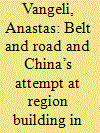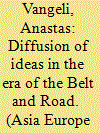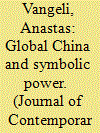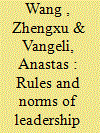|
|
|
Sort Order |
|
|
|
Items / Page
|
|
|
|
|
|
|
| Srl | Item |
| 1 |
ID:
178212


|
|
|
|
|
| Summary/Abstract |
This article analyses China’s Belt and Road as a medium through which novel regional development ideas and practices are being generated, (re)articulated, and diffused, via a case study of its implementation in the broader region of Central-East and Southeast Europe (CESEE). The example of CESEE shows that via the Belt and Road, Chinese actors have advanced comprehensive region work based on social interactions, which includes regular high-level diplomatic exchange and quasi-institutionalisation as well as people-to-people relations, resting on the potent geoeconomic imaginaries of the New Silk Roads. This approach, in the case of CESEE, has allowed for regional co-operation to advance even in times of friction and uncertainties. Nevertheless, as region work is essentially a contentious endeavour, China’s attempt at regionalism in CESEE has been challenged by the European Union (EU), the United States and regional actors who feel uneasy about China’s advance.
|
|
|
|
|
|
|
|
|
|
|
|
|
|
|
|
| 2 |
ID:
155246


|
|
|
|
|
| Summary/Abstract |
This paper provides an overview of China's burgeoning relationship with Central, East and Southeast Europe (CESEE) in the context of the Belt and Road Initiative (BRI). China has rapidly expanded the extent of its interactions with CESEE since 2012, and this region has subsequently become one of the focal points of the BRI. The key feature of China's engagement with CESEE is the devising of an experimental and innovative approach, demonstrated in the establishment of an institutional mechanism for cooperation with a particular group of 16 CESEE countries (16+1). The case of China–CESEE relations offers an insight into how, in the era of the BRI, China is complementing its economic approach with institution-building and policy coordination. The article concludes that as the BRI progresses, these tendencies will remain central to China's relations with CESEE.
|
|
|
|
|
|
|
|
|
|
|
|
|
|
|
|
| 3 |
ID:
169132


|
|
|
|
|
| Summary/Abstract |
To address part of the puzzle on China’s ideational impact in the era of the Belt and Road Initiative (BRI), the article studies social interaction of Chinese and CEE think tanks by employing the concept of diffusion of ideas. The article proposes a theoretical framework to study diffusion inspired by reflexive social science that focuses on frames, (geoeconomic) imaginaries, and translations. The asymmetrical interaction of think tanks led to aligning the frames of the different actors and producing a context of peaceful and pragmatic cooperation, extension of the geoeconomic imaginaries to include previously unorthodox positions, and translation of policy concepts that are localized in accord with the dispositions of the CEE actors involved. Nevertheless, the China–CEE think tank cooperation, when analyzed in a broader context, has relatively limited impact on societal and policy levels, and is increasingly challenged by actors with greater leverage in the region. What sustain the diffusion of ideas are the potent narratives of imagined futures of prosperity under the New Silk Roads.
|
|
|
|
|
|
|
|
|
|
|
|
|
|
|
|
| 4 |
ID:
160833


|
|
|
|
|
| Summary/Abstract |
This article analyzes the practice and effects of China’s new foreign policy by applying a research framework inspired by Bourdieu(s)ian international political sociology centered on the notion of symbolic power. To analyze China’s symbolic power in action, the article uses the case of the cooperation between China and the 16 countries of Central, East, and Southeast Europe, dubbed ‘16 + 1’. It discusses how, through symbolic domination that rests on concealing the true meaning of the cooperation, China contributes to changes in the established notions on boundaries, historical legacies, and development paradigms in the region of Central and Eastern Europe (CEE).
|
|
|
|
|
|
|
|
|
|
|
|
|
|
|
|
| 5 |
ID:
169128


|
|
|
|
|
| Summary/Abstract |
China’s relations with Central and Eastern Europe (CEE) have been progressively attracting attention in recent years. In the last decade, China sought to restore the “bridges” (Wasserstrom 2000) with the region that had existed in the period 1949–1989. Chinese policymakers have long contemplated their “return” to CEE (Tubilewicz 1998); however, they have found the right opportunity only in the period after the global financial crisis. The first trade and investment summit of China and the sixteen countries in the region—Albania, Bulgaria, Croatia, the Czech Republic, Estonia, Hungary, Latvia, Lithuania, Montenegro, (North) Macedonia, Poland, Romania, Serbia, Slovakia, and Slovenia—took place in Budapest in 2011. In 2012, the first summit of the heads of governments of China and the sixteen (collectively known as 16+1) took place in Warsaw. Ever since, these summits have been taking place once a year, while a web of coordinating institutions and mechanisms spanning a number of policy fields has been also established. There is now a whole new universe of interactions involving governmental actors on the national, regional/provincial, and local levels, state-owned and private enterprises, think tank(er)s, and media professionals, as well as other people-to-people exchanges, which now take place with growing frequency and contribute to development of China–CEE relations.
|
|
|
|
|
|
|
|
|
|
|
|
|
|
|
|
| 6 |
ID:
145795


|
|
|
|
|
| Summary/Abstract |
Under Deng Xiaoping, the Chinese Communist Party started to institutionalize leadership succession in the 1980s. Peaceful and orderly succession of the top political offices, however, only started to take shape in the early 1990s. We identify three sets of rules and norms formed since then to govern elite replacement and power succession. These concern top leaders’ exit from power, selection of successors, and the transition of power between outgoing and incoming leaders. We trace the evolving process in which these rules were made and accepted by the Party elite between 1992 and 2012. Incidents, however, also showed the malleability of some of these rules and the potential rise of ambitious rule challengers. Into Xi Jinping’s era, uncertainty still threatens the revision or abandonment of some of these rules, and continuous attention is needed in order to understand the likely trajectories of the Chinese political system.
|
|
|
|
|
|
|
|
|
|
|
|
|
|
|
|
|
|
|
|
|